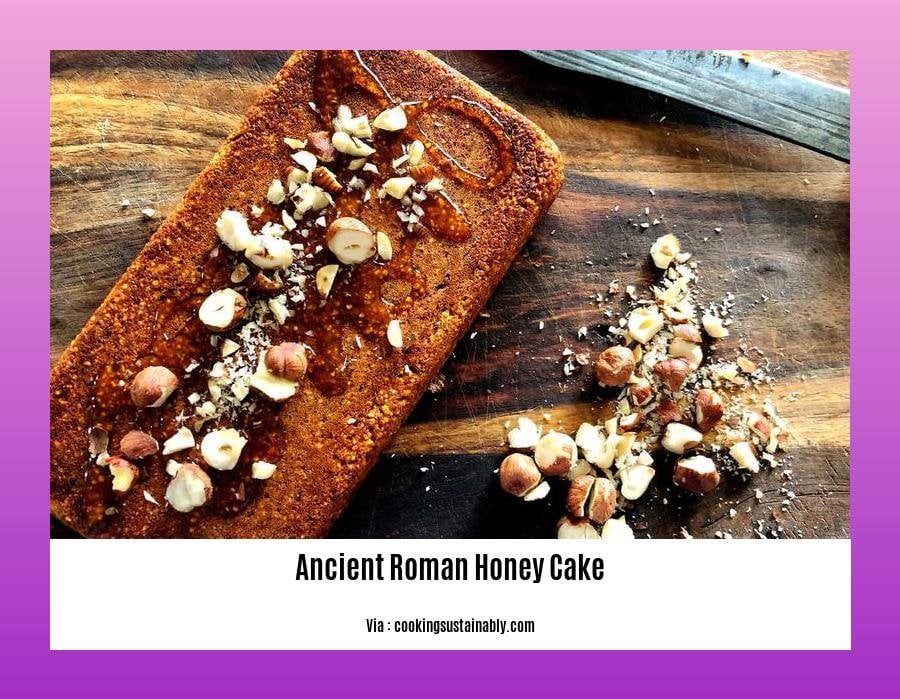Embark on a culinary time travel to ancient Rome with us as we unravel the secrets of their delectable honey cake. This delectable treat, steeped in history and symbolism, played a significant role in Roman culture. Join us as we explore ancient recipes, decode culinary symbolism, and experiment with hands-on re-creations to bring this ancient delicacy back to life. Discover the significance of honey in Roman cuisine, the unique ingredients they used, and how their techniques have influenced modern-day baking. [- A Journey Through Time: Unraveling the Secrets of Ancient Roman Honey Cake] promises a captivating exploration of culinary history and a taste of the past.
Key Takeaways:
Ancient Roman honey cake, known as Libum, was popular in ancient Rome.
The recipe for Libum is found in the Roman cookbook, Apicius, from the 3rd or 4th century CE.
Ingredients include freshly ground wheat flour, dried yeast, rosemary, cinnamon, ground almonds, passum (ancient Roman wine), pepper, pine nuts, and honey.
Libum was a sacred food served during religious festivals and ceremonies as an offering to the gods.
Its flavor profile combines sweet honey, nutty almonds, and subtle spices like cinnamon and rosemary.
Ancient Roman Honey Cake

Experience the culinary heritage of ancient Rome through the delectable ancient Roman honey cake, also known as Libum.
Delve into the history of this sacred bread, dating back to the 3rd or 4th century CE, and uncover the secrets behind its unique flavor profile. Libum holds a special place in Roman culture, often served as an offering to the gods during religious festivals and ceremonies, symbolizing gratitude and devotion.
Unraveling the Secrets of Libum
Libum’s distinctive taste comes from a harmonious blend of simple yet flavorful ingredients. Freshly ground wheat flour provides a hearty base, while dried yeast ensures a light and airy texture. The addition of rosemary and cinnamon imparts a subtle yet aromatic touch, while ground almonds add a nutty richness.
Passum, an ancient Roman wine, lends a sweet and slightly tangy note, complemented by the warmth of pepper and the crunch of pine nuts. Of course, no honey cake would be complete without the sweetness of honey, the key ingredient that ties all the flavors together.
Taste of History
Imagine taking a bite of the ancient Roman honey cake, savoring the complex interplay of flavors and textures. The sweetness of honey and passum dances on your tongue, while the nutty almond and subtle spices linger in the background. The result is a harmonious balance that showcases the culinary expertise of ancient Rome.
Libum’s Legacy
The ancient Roman honey cake continues to inspire modern-day bakers and culinary enthusiasts. Its unique flavor profile and historical significance have earned it a place in contemporary baking, where it stands as a testament to the enduring legacy of Roman cuisine.
Whether you’re a history buff, a culinary adventurer, or simply someone with a sweet tooth, the ancient Roman honey cake is a must-try. Its distinct taste and cultural significance make it a culinary treasure that deserves to be savored and appreciated.
For an authentic ancient Roman taste, try this ancient Roman honey cake recipe, a treat that has stood the test of time. Curious about what names ancient Romans had? Generate an ancient Roman name and discover the moniker that could have been yours in another era.
Ancient Roman Cake Recipes

As a culinary historian with a passion for ancient Roman cuisine, I’m excited to delve into the fascinating world of their honey cakes. These ancient treats, known as Libum, were more than just desserts; they held cultural and religious significance, often served as offerings to the gods.
Key Takeaways:
Ancient Roman honey cakes, also known as Libum, were a staple in Roman cuisine, dating back to the 3rd or 4th century CE.
Libum was not just a sweet treat but also held religious importance, often served as offerings to gods during festivals and ceremonies.
The unique flavor profile of these cakes comes from a blend of honey, nuts, spices, and wine, creating a taste that’s both sweet and savory.
The Libum recipe, found in the ancient Roman cookbook Apicius, calls for ingredients like wheat flour, yeast, rosemary, cinnamon, almonds, pepper, pine nuts, and honey.
Despite its historical significance, Libum remains a relatively unknown culinary treasure, waiting to be rediscovered and enjoyed by modern-day enthusiasts.
Unraveling the Secrets of Libum
Libum was more than just a cake; it was an edible symbol of devotion, a link between mortals and the divine. Its ingredients were carefully chosen, each representing a different aspect of the gods’ powers. Honey, a symbol of purity and sweetness, was a natural choice to honor the gods. Almonds, with their rich, nutty flavor, represented strength and fertility. Spices like cinnamon and rosemary added a touch of warmth and complexity, while pepper provided a subtle kick, symbolizing the gods’ fiery nature.
Recreating Libum Today
While Libum is a product of its time, its flavors and symbolism continue to resonate with modern-day bakers and food enthusiasts. With a bit of research and experimentation, it’s possible to recreate these ancient cakes in our own kitchens, bringing history to life. However, it’s important to remember that Libum is not just a recipe; it’s a cultural artifact that deserves respect and understanding.
Citations:
Ancient Roman Honey Cakes
Libum: Roman Honey Cakes
Ancient Roman Recipes
Key Takeaways:
In ancient Rome, honey cakes, known as Libum, were a culinary delight with religious significance, served as offerings to gods during festivals and ceremonies.
The unique flavor profile of Libum is attributed to a harmonious blend of honey, nuts, spices, and wine, resulting in a sweet yet savory taste.
Libum embodied more than just a cake; it served as an edible symbol representing various aspects of the gods’ powers, symbolizing devotion and gratitude.
While Libum remains a relatively unexplored culinary treasure, it offers insights into ancient Roman culinary practices and provides an opportunity to connect with the past through taste.
With the availability of the recipe, it is possible to recreate Libum in modern-day kitchens, although it’s important to approach it with respect and understanding of its historical significance.
Libum stands as a testament to the ingenuity and culinary skills of the ancient Romans, a reminder of their rich culinary heritage that continues to inspire modern-day culinary creations.
[Citations]
FAQ
Q1: What were the key ingredients used in ancient Roman honey cakes?
A1: Ancient Roman honey cakes were made using ingredients such as flour, honey, eggs, olive oil, and a variety of spices like cinnamon, cumin, and anise. These ingredients were readily available and reflected the culinary preferences of ancient Rome.
Q2: On what occasions were ancient Roman honey cakes typically served?
A2: Ancient Roman honey cakes held significant cultural and religious importance. They were commonly served during religious festivals and ceremonies as offerings to the gods or as symbols of good fortune and prosperity. These cakes were also enjoyed as a sweet treat during special occasions and celebrations.
Q3: How were ancient Roman honey cakes prepared?
A3: The preparation of ancient Roman honey cakes involved mixing dry and wet ingredients, allowing the dough to rise, and baking it until golden brown. Detailed recipes can be found in ancient Roman cookbooks such as Apicius, providing insights into the culinary practices of that era.
Q4: What is the significance of ancient Roman honey cakes in understanding ancient Roman culture and cuisine?
A4: Ancient Roman honey cakes offer a glimpse into the culinary practices, traditions, and beliefs of ancient Rome. They reflect the use of local ingredients, the importance of religious rituals, and the appreciation for simple yet flavorful dishes. By studying these cakes, we can gain insights into the daily lives and饮食文化 of the ancient Romans.
Q5: Can ancient Roman honey cakes be recreated today?
A5: Yes, it is possible to recreate ancient Roman honey cakes using modern ingredients and techniques. While some adaptations may be necessary, the essence of the original recipe can be preserved. Home cooks and culinary enthusiasts can find detailed recipes and instructions online or in historical cookbooks, allowing them to experience the flavors and traditions of ancient Rome in their own kitchens.
- Senior at What Age: Benefits & Eligibility Guide - March 29, 2025
- Unlocking Senior Benefits: How Old is a Senior? Your Complete Guide - March 29, 2025
- Master Russian Politeness:A Guide to Saying Please - March 29, 2025
















